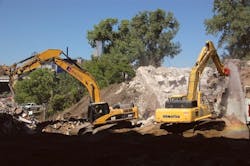The two-story fort-like structure that was used to study building blocks of atoms sat almost unnoticed for nearly half a century on the East Bank of the University of Minnesota campus in Minneapolis. Very few people knew about the unusual building because of its location and privacy that was needed for scientific experiments.
Now the tandem accelerator building, one of only eight in the world when it began operations in 1969, has been demolished and removed by Rachel Contracting, St. Michael, Minn. Although the modest-sized building was approximately 32,000 square feet, it presented the construction company with significant challenges, including breaking up concrete walls that were three to five feet thick in places that used to contain low-level radiation from experiments.
Located on what is commonly known as the “river flats” along the Mississippi River, the building sat at the bottom of a high and steep hill that is covered by trees and thick underbrush. A large steam-generation plant nearby and the I-35W bridge overhead kept the building out of sight to students and others walking along the top of the hill, driving in cars over the bridge, or cruising down the Mississippi River.
Access to the site was by narrow and steep switchback roads, which made it difficult for large lowboy trucks to deliver two large excavators needed for the demolition: a Caterpillar 330 and a Komatsu PC400LC.
The demolition itself was accomplished using conventional methods of knocking down the roof and walls with the excavators. The Komatsu was equipped with a Genesis hydraulic hammer that relentlessly pummeled the thick concrete walls to penetrate and fracture them into pieces. Rachel’s crew used the Cat excavator to remove concrete and all debris, load them into dump trucks and, at times, fitted the Cat with a Genesis muncher attachment to crush some sections of the walls and large pieces of broken concrete.
The demolition also included dismantling and removing the accelerator itself, which looked like a small submarine. The machine was 80 feet long, 13 feet wide, and was built from 120 tons of steel that was two to three inches thick in many places. Rachel crews used acetylene torches for several weeks to cut the machine into pieces and remove them for recycling.
In addition to removing all the steel and tons of concrete, more than 90 percent of which was recycled, Rachel’s crew of up to six workers backfilled clean fill and restored the property to green space, according to Nick Bartemio, project manager for Rachel. Before the company began the project early in July, the building was thoroughly tested for any residual radiation and found to be safe.
Potential vibration from demolishing all the concrete was also a significant concern because of a large tunnel that ran inside the large hill, which was only 13 feet behind the accelerator building, leading up to a road. The tunnel connects to a large network of other tunnels with pipes inside of them to deliver steam for heating nearly every building on the university’s campus.
Vibration, erosion concerns
However, the contractor decided to leave the back wall of the building in place because of its close proximity to the hill and steam tunnels. No one wanted to risk damaging the tunnel and sensitive gauges and controls inside of it, which in turn would jeopardize the university’s ability to deliver heat, especially with the fall term starting and cold winter months soon to follow.
With the Mississippi River less than 100 feet from the demolition site, workers had concerns about erosion control. Rachel installed silt fences early on and frequently checked them to prevent debris from washing into the river. In addition, the company constructed two storm water retention basins.
Construction on the accelerator building began in 1964. The facility was active beginning in 1969 and continuing for about 10 years. The massive tandem accelerator used a high-voltage, two-stage design to propel atomic particles into the nuclei of other atoms. Scientists would then analyze how the particles reacted.
Eventually the need for particle research diminished and funding disappeared, according to a report by Minnesota Public Radio. The last known project was in 1992 to study the structure of a steel alloy.
After the collapse of the I-35W bridge, state and University officials became concerned about the safety of this building despite the lack of any visible damage. With the building’s age and lack of research funding, the university decommissioned the building, dismantled and removed the electronics and other components from inside the accelerator, and contracted with Rachel, an earthwork and demolition contractor, to demolish the facility.
Richard Parrish is president of Mindshare Communications, a PR and communications agency in Long Lake, Minnesota.
